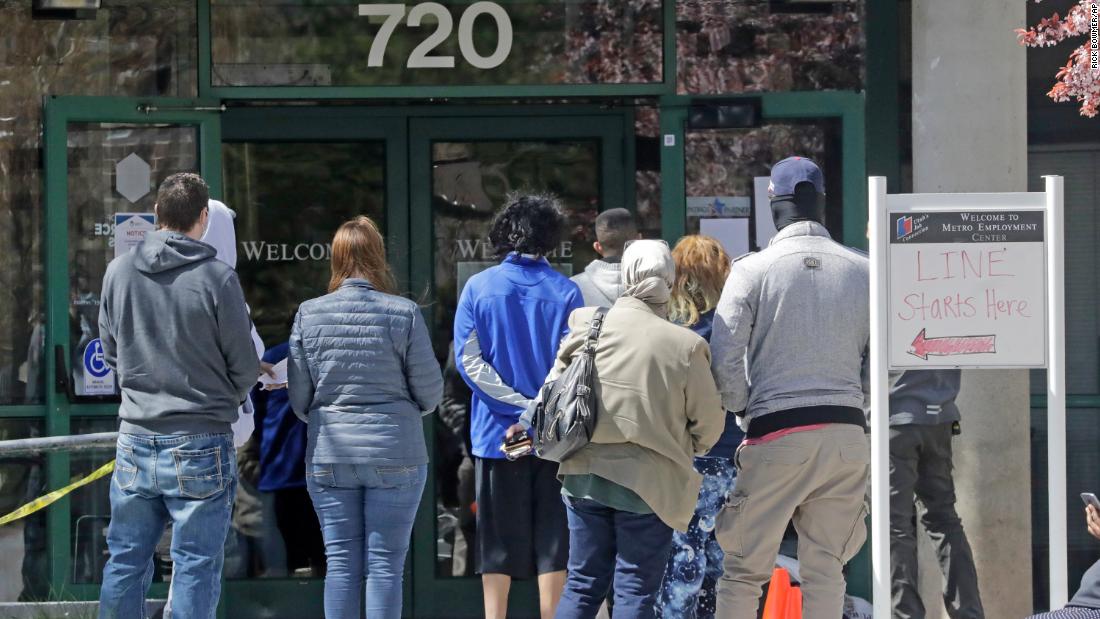
Another 5.2 million workers filed for their first week of unemployment benefits last week, according to the US Department of Labor, bringing the total number of Americans who have filed initial jobless claims to around 22 million, or roughly 13.5% of the labor force, since March 14.
Overall, the last four weeks have marked the largest and most dramatic rise in claims on record since the Labor Department started tracking the data in 1967. It is straining state unemployment agencies' ability to handle the crush of filers and threatening to drain some states' unemployment trust funds in coming weeks.
Other jobs crises have played out far more slowly. In the Great Recession, for example, employment declined by 8.6 million workers between its peak in November 2007 and trough in December 2009.
This time, mass layoffs and furloughs came suddenly as states enacted lockdowns of all but essential businesses to slow the spread of the coronavirus pandemic.
The country's official unemployment rate, which climbed to 4.4% in March, from a historic low of 3.5% in February, is now expected to hit double-digits in April.
"April is bound to be truly shocking," Brian Coulton, chief economist at Fitch Ratings wrote in emailed comments. He estimates the unemployment rate could rise to about 15% in April — a new post-World War II high.
During the coronavirus pandemic, layoffs initially hit service jobs the hardest. Workers at retailers, restaurants and hotels, for example, were among the first to lose their jobs.
Now, as a deep economic downturn takes hold, job losses could start to hit white collar office jobs, too.
"As shutdowns continue, job losses will likely extend into other areas of the labor market, such as business and professional services where firms may begin to see lower revenues from a second order pull back in demand," Robard Williams, a senior vice president for Moody's Investors Service noted.
Many economists believe that a spike in unemployment will be temporary and that many — but not all — of the lost jobs will come back when the coronavirus crisis is over. But ultimately, their forecasts are highly uncertain, and the economic recovery will depend on the course of the virus.
Until a recovery sets in, consumer confidence and spending will also decline.
"Given the outsized impact consumers have not only on the US economy, but the global economy, is going to hurt," said Michael Arone, chief investment strategist at State Street Global Advisors.
A shock to America's unemployment system
Meanwhile, skyrocketing claims continue to overwhelm state labor departments. Many state agencies are hiring additional workers and rushing to push out technology updates to tend to the applications.
Initial claims represent first-time applications for unemployment benefits, and not all of those applications result in people receiving benefits. As of the week ending April 4, about 12 million Americans were receiving benefits, according to the Department of Labor. That number is also at an all-time high. In contrast, at the height of the Great Recession, no more than 6.5 million workers were on unemployment benefits at any given time.
Soon, some states are also expected to run low on funding for unemployment benefits.
Six states — including New York, which has the highest number of cases in the US — can only fund up to 10 weeks of unemployment benefits from their state coffers before money runs out and they have to turn to the federal government for additional funding, according to a recent estimate from the Tax Foundation.
Another 15 state trust funds don't meet the federal Department of Labor's recommended minimum solvency standard, which requires being able to pay benefits for a year in an economic downturn similar to the Great Recession.
The cash crunch won't affect the millions of Americans currently applying for or receiving benefits -- they'll get their weekly checks regardless of their state's financial situation.
States remain responsible for their share of unemployment insurance, which typically lasts up to 26 weeks. If their trust funds run out, they could take loans from the federal government -- but some states could wind up paying interest and employers could face heftier taxes to cover the debt. Other choices: Issue bonds or draw down other state funds, which most states can ill afford as the coronavirus wreaks havoc on tax revenues.
"Most states have relatively few options," said Jared Walczak, director of state tax policy at the Tax Foundation. "States will have to borrow extensively. Ultimately, this will likely lead to higher taxes both at the federal and state level on businesses, which states want to avoid as long as possible."
But states aren't on the hook for the historic expansion of the unemployment benefits program recently passed by Congress as part of its economic relief package. The federal government is footing the bill for the temporary $600 boost in weekly payments and short-term expansion of benefits to those affected by the coronavirus and the self-employed -- which is projected to cost about $250 billion.
Many self-employed people and gig workers, however, have said they're struggling to access those benefits, however, because of processing delays and systems that were not equipped to handle applications from self-employed workers.
-— CNN Business' Clare Duffy contributed to this report.
"last" - Google News
April 16, 2020 at 10:03PM
https://ift.tt/2z0rIb2
22 million Americans have filed for unemployment benefits in the last four weeks - CNN
"last" - Google News
https://ift.tt/2rbmsh7
Shoes Man Tutorial
Pos News Update
Meme Update
Korean Entertainment News
Japan News Update
Bagikan Berita Ini
















0 Response to "22 million Americans have filed for unemployment benefits in the last four weeks - CNN"
Post a Comment